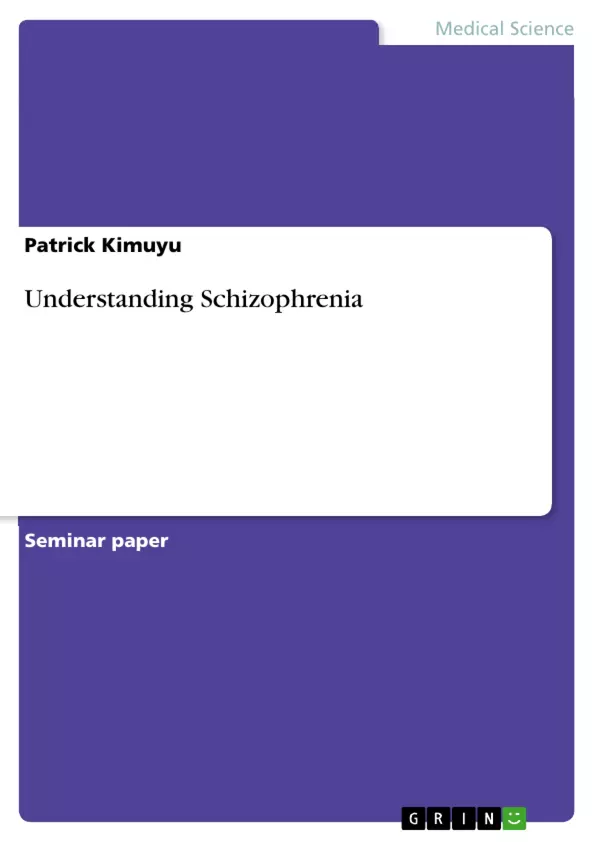Schizophrenia is a psychotic disorder affecting all people, worldwide. Its prevalence is higher among males than females in which its onset is 25 years and 27 years in men and women, respectively.
The causes of this disorder are associated with genetic and environmental factors. Some genetic factors increase vulnerability of an individual to the disease, whereas environmental factors trigger the disease in vulnerable individuals.
Its main signs and symptoms include delusions, disorganized speech, catatonic behavior, and hallucinations.
Diagnosis of schizophrenia is based on DSM and ICD-10 criteria, and it involves differential diagnosis of other psychotic and medical issues.
Overall, the pathophysiology of this illness is related to abnormalities in brain structure, neurotransmitter and immune system. As such, treatment aims at addressing the symptoms of the disorder in which antipsychotic medication and psychosocial interventions serve as the main treatment approaches.
Regarding prognosis of schizophrenia, inadequate access to healthcare increases mortality. Suicide is one of the main causes of mortality among people with schizophrenia.
Conclusively, schizophrenia presents immense challenges, but research has been instrumental in improving its diagnosis and treatment.
Table of Contents
- Introduction
- Causes of Schizophrenia
- Hereditary Factors
- Environmental Factors
- Abnormalities in brain structure and chemistry
- Signs and Symptoms of Schizophrenia
- Early Warning Signs
- Delusions
- Hallucinations
- Disorganized Behavior
- Disorganized Speech
- Negative Symptoms
- Diagnosis of Schizophrenia
Objectives and Key Themes
This paper aims to provide a comprehensive overview of schizophrenia, a psychotic disorder that poses significant challenges to psychiatrists and public health professionals. It explores the causes, signs and symptoms, diagnosis, and treatment of this complex and debilitating condition.
- The complex interplay of genetic and environmental factors in the onset of schizophrenia.
- The diverse signs and symptoms of schizophrenia, including delusions, hallucinations, disorganized behavior, and negative symptoms.
- The challenges associated with diagnosing schizophrenia, including the need for comprehensive psychiatric evaluation and the use of specific diagnostic criteria.
- The impact of schizophrenia on an individual's social functioning, behavior, and thoughts.
- The importance of research in improving the diagnosis and treatment of schizophrenia.
Chapter Summaries
- Introduction: This chapter introduces schizophrenia as a complex and debilitating psychotic disorder with significant impact on social functioning, behavior, and thoughts. It highlights the global prevalence, demographic inequalities, and mortality associated with the disorder.
- Causes of Schizophrenia: This chapter examines the causes of schizophrenia, focusing on the interplay between genetic and environmental factors. It discusses the role of hereditary factors, including genetic predisposition and family history, as well as the influence of environmental factors such as psychosocial stress, viral infections, and childhood trauma. The chapter also explores the potential contribution of abnormalities in brain structure and chemistry.
- Signs and Symptoms of Schizophrenia: This chapter describes the different phases and types of symptoms associated with schizophrenia. It covers early warning signs, such as social withdrawal, hostility, and depression, as well as the five main symptoms: delusions, hallucinations, disorganized behavior, disorganized speech, and negative symptoms. Each symptom is elaborated on with specific examples and details.
- Diagnosis of Schizophrenia: This chapter focuses on the process of diagnosing schizophrenia, highlighting the challenges posed by its resemblance to other psychotic disorders. It emphasizes the importance of comprehensive psychiatric evaluation, physical examination, medical history, and clinical laboratory tests. The chapter also discusses the use of diagnostic criteria, such as DSM-5 and ICD-10, and explains the specific criteria required for a diagnosis.
Keywords
Schizophrenia, psychosis, delusions, hallucinations, disorganized behavior, negative symptoms, genetic factors, environmental factors, brain structure, neurotransmitters, diagnosis, treatment, antipsychotic medication, psychosocial interventions, prevalence, mortality, disability.
- Quote paper
- Patrick Kimuyu (Author), 2018, Understanding Schizophrenia, Munich, GRIN Verlag, https://www.grin.com/document/388763



